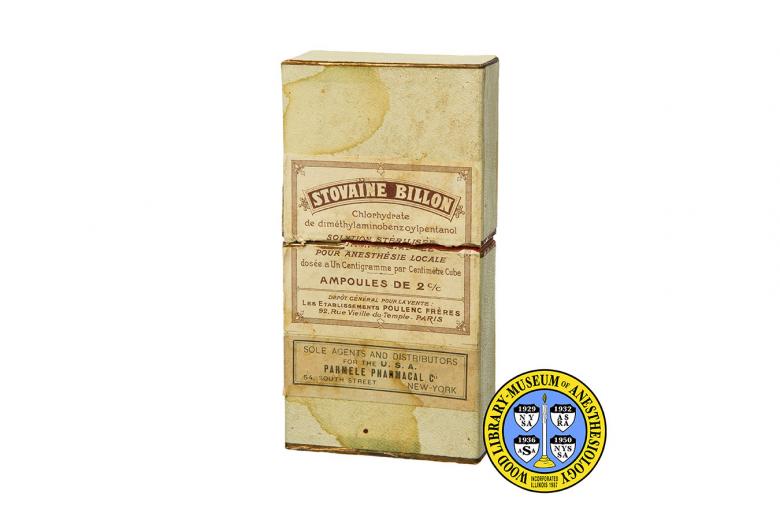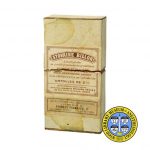Stovaine
The modern era of regional anesthesia began in 1884, with Dr. Koller's introduction of cocaine injections. Non-addictive alternatives were sought immediately. Stovaïne, the brand name for the local anesthetic amylocaine, was synthesized by the French chemist Ernest Fourneau (1872–1949) shortly after he became the research director for the pharmaceutical company Établissements Poulenc Frères. On July 5, 1904 at a meeting of the l'Académie Nationale de Médecine, French surgeon Paul Reclus (1847-1914) reported on his successful experiences using Stovaïne for local anesthesia and epidural injections. Within a month or two, this news was reported in British, Canadian and American medical journals, and by 1909 stories of this new local anesthetic were being covered in popular publications such as The New York Times and McClure’s Magazine.
The original French name, Forneaucaine, was unacceptable in English-speaking countries. So it was changed to Stovaine (the French word "forneau" means "stove" in English.) For a time, the new agent was an exciting alternative to cocaine, as it was non-addictive and produced less severe side effects. It could be applied topically or injected, and was best known for its use in spinal anesthesia. By the 1940s, it had been replaced by more recently developed local anesthetics.
Catalog Record: Stovaine
Access Key: akgh
Accession No.: 2003-07-21-1
Title: Stovaïne billon : chlorhydrate of diméthylaminobenzoylpentanol /
Établissements Poulenc Frère.
Author: Fourneau, Ernest, 1872–1949.
Corporate Author: Établissements Poulenc Frère.
Title variation: Alt Title
Title: Stovaïne billon : ampoules de 2 c/c.
Title variation: Alt Title
Title: Amylocaine.
Title variation: Alt Title
Title: Stovaine.
Publisher: Paris : Établissements Poulenc Frère ; New York : Parmele Pharmacal Co. (US
distributors), [1904-1928].
Physical Descript: 1 box ; paper, cardboard : 12.5 x 6.5 x 2.5 cm. + 12 glass ampoules.
Subject: Drug Packaging.
Subject: Anesthetics, Local.
Subject: Amylocaine.
Note Type: General
Notes: Years of possible manufacture based on year of introduction and year of
company name change from Établissements Poulenc Frère.to Rhône-Poulenc SA
(1928).
Note Type: With
Notes: Held within the box (or container) are 12 glass ampules that taper at both
ends; The ampules measure approximately 11.8 cm and .9 cm in diameter; A
labal is applied in a spiral arround the center of each ampoule; The text on
the labels includes, “STOVAÏNE – Billon”, and “STOVAINE à 1 %”; Within the
box each ampule is cradled in a cardboard tube.
Note Type: Citation
Notes: Applications of Stovaine to general surgery. Can J Med Surg. October,
1905:18(4):lxx.
Note Type: Citation
Notes: Ball C, Westhorpe R. Local anaesthetics–procaine (Novocaine, Ethocaine).
Anaesth Intensive Care. 2004;32(3):303.
Note Type: Citation
Notes: Bulletin de l’Académie de Médecine French, Paris: 35. new anesthetic. JAMA.
August 20, 1904;43(8):575.
Note Type: Citation
Notes: Fourneau, Ernest.Complete Dictionary of Scientific Biography. Vol. 5. 7th ed.
Detroit: Charles Scribner’s Sons; 2008:99-100.
Note Type: Citation
Notes: Hendrick BJ. The new anesthetic – Stovaine. McClure’s Magazine. March,
1910:34(5):565-575.
Note Type: Citation
Notes: Kendirdjy L. L’Anesthésie Chirurgicale par la Stovaïne. Paris: Masson;
1906:vii-viii. https://gallica.bnf.fr/ark:/12148/bpt6k56750673/f10.image.
r=L%27anesth%C3%A9sie.langFR. Accessed March 6, 2013.
Note Type: Citation
Notes: Luke TD. Stovaine-a synthetic analgesic. Scott Med Surg J. 1905:17;143-152.
Note Type: Citation
Notes: Ravina E. Dr. Ernest Fourneau’s legacy. The Evolution of Drug Discovery: From
Traditional Medicines to Modern Drugs. Weinheim, Germany: Wiley-VCH;
2011:45-46.
Note Type: Citation
Notes: Reclus P. L’analgésie locale par la stovaine. Bull Acad Natl Méd. July 5,
1904;52:7-11.
Note Type: Citation
Notes: Succeeds with Stovaine: Trenton patient talks with doctors as growth is cut
away. New York Times. December 23, 1909:18.
Note Type: Citation
Notes: Surgeons deplore use of Stovaine: authorities here think spinal injections
too dangerous for general proactice. New York Times. December 4, 1909.
https://query.nytimes.com/gst/abstract.
html?res=F20F17FD3F5C15738DDDAD0894DA415B898CF1D3. Accessed March 6, 2013.
Note Type: Physical Description
Notes: One cardboard box, or container, with a telescoping lid, for ampules of a
local anesthetic; The paper on the outside has a slightly rough texture and
is light tan with some gold trim; It is also soiled and marked with water
stains; Two labels on the front of the box are marked with agent and
manufacturer information; The larger label measures approximately 5.7 x 6.7
cm. in height and width; Text on the larger label includes, “STOVAÏNE BILLON
[new line] Chlorhydrate [new line] de diméthylaminobenzoylpentanol”,
“SOLUTION STÉRILISÉ [new line] POUR ANESTHÉSIE LOCALE [new line] dosée a Un
Centigramme per Centimètre Cube”, “AMPOULES DE 2 c/c”, “DÉPÔT GÉNÉRAL POUR LA
VENTE : [new line] Les Etablissements POULENC FRÈRES [new line] 92, Rue
Vieille du Temple- PARIS”; A smaller label is place just below the larger
one; Text on the smaller label includes, “SOLE AGENTS AND DISTRIBUTORS [new
line] FOR THE U.S.A. [new line] PARMELE PHARMACAL Co [new line] 54 SOUTH
STREET [5 spaces] NEW-YORK”
Note Type: Reproduction
Notes: Photographed by Mr. Steve Donisch on January 14, 2013.
Note Type: Historical
Notes: Stovaïne, the brand name for the local anesthetic amylocaine, was synthesized
by the French chemist Ernest Fourneau (1872–1949) shortly after he became the
research director for the pharmaceutical company Établissements Poulenc
Frères. Later, in 1911, Fourneau joined the Pasteur Institute where he lead a
team that developed of a number of other important classes of drugs,
including sulfonamide antibiotics, alpha blockers, and antihistamines.
Note Type: Historical
Notes: On July 5, 1904 at a meeting of the l’Académie Nationale de Médecine French
surgeon Paul Reclus (1847-1914) reported on his successful experiences using
Stovaïne for local anesthesia and epidural injections. Within a month or two,
this news was reported in British, Canadian and American medical journals,
and by 1909 stories of this new local anesthetic were being covered in
popular publications such as The New York Times and McClure’s Magazine.
Note Type: Historical
Notes: Possibly a reflection of the widespread work to find a local anesthetic that
could replace cocaine, amylocaine was developed around the same time as the
local anesthetic procaine (Novocaine). Both of these local anesthetics were
found to be effective and produce less adverse results than cocaine. Although
procaine continues to be used in some clinical settings, both amylocaine and
procaine have largely been preplaced by more recently developed local
anesthetics.
Note Type: Historical
Notes: In other countries, amylocaine may be referred to as amyleine or dolodent.
Note Type: Publication
Notes: Henry TA. Obituary notices: Ernest Fourneau, 1872–1949. J Chem Soc.
1952:261-272.
Note Type: Exhibition
Notes: Chosen for the WLM website (noted February 26, 2013).


